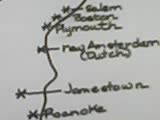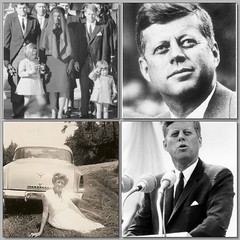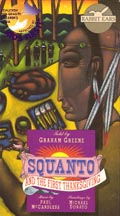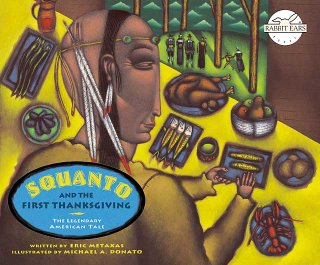
This post is probably my longest yet. Yes, I know…..many of my posts are rather wordy. I even thought about cutting this one down a bit or even making it two posts instead of one. I decided I wouldn’t. To delete any part of it would be a disservice to the men of the 104th and to my Uncle Robert. I don’t think Uncle Robert’s story can be told without without sharing details about the Timberwolves and their brave contribution to our victory over the Nazis.
I remember my Uncle Robert as a quiet, sweet soul. For many years I spent at least one week….sometimes two…. every year at his house. I remember a regimented man who maintained a schedule of getting up, going to work, dinner, a little television, his Bible, and then off to bed. I never heard him raise his voice even though I know he was a firm yet loving disciplinarian with his children. There was just something about Uncle Robert that made you want to please him. You never wanted to let him down by allowing him see you talk in church or by doing anything else you knew he would disapprove of. I remember early on summer mornings I would wake up in his home and lay there and listen as I heard the hushed tones of Uncle Robert and Aunt Claudine while they shared a quick breakfast together before he was off to work. Their private time together made me feel safe and secure.
As I was growing up I knew he was in the Army during World War II but until the last few years I didn’t know to what extent he served. Through his children I learned as I was growing up a little about Uncle Robert’s service. He made sure his children knew that World War II was necessary and that soldiers had fought to keep America free. He told them interesting stories about the war and his participation in it. Some of the stories were good, many were sad, but all were heroic.
The West family sent four sons off to war at the same time though their paths never crossed while they were in Europe. Uncle Robert was a Staff Sergeant in G Company, 104th Division, 414th Infantry, of the United States Army that landed in Cherbourg, France on September 7, 1944. They were the first American division to arrive on French soil without having first stopped in England. The 104th travelled to Europe via the
USS Lejeune, the
USS George Washington, the
SS Ocean Mail, and the
USAT Cristobal.
Once on European shores it is possible Uncle Robert along with other members of the 104th participated in the ‘Red Ball Express’, a circular 24-hour-a-day truck supply route from the invasion beaches to the front which had been in operation for some time before their arrival. My research indicates the 104th filled a support role for a few days before taking up defensive positions in the vicinity of Wuustwezel, Belguim on October 23, 1944.
The 104th was to relieve the British 49th Division and join the First British Corps, First Canadian Army. They were the first regiment of the American Army to relieve an allied unit on the Western Front, as well as the first American Regiment to fight under the control of an Allied Army.
Fellow soldier,
Bob Bilinsky recollects that “G Company moved onto a dirt lane and then into an open area which seemed to stretch forever towards what we assumed to be the German positions.” As the Scottish soldiers they were to replace hopped happily out of their foxholes the soldiers of G Company were to take their place. Bilinsky recounts many of the Americans were “amazed at the complete disdain [the Scotts] seemed to have for the fact they presented an easy target for Germans gunfire! Suddenly it happened! The silence was shattered! Not by gunfire but by the loud strains of the Scottish bagpiper as the unit marched away in a swaying but perfect cadence to the pulsating beat of the music.” Bilinsky advised that “more than a few of us smiled” and “perhaps members of G Company owe that bagpiper a ‘Thank You’ for helping [them] lose just a little of the nervous edge [they] had built up on [their] first assignment for front line duty.” I can just imagine how my uncle (a mere country boy from the North Georgia foothills) must have jumped as the Scottish bagpipes began their initial whining. I’m sure; however, he was ready to cheer along with the other men of G Company as the cadence became a dual anthem of the Scots’ relief at leaving the foxhole and one of breaking the tension of an untested pack of wolves.
The Timberwolves soon had no reason to doubt their abilities.Once in Holland Uncle Robert and the men of the 104th began a series of 195 days of continuous combat with the Battle of the Dikes through Holland. My uncle told his children tales about crawling on his stomach, probing the ground inch by inch with a knife in order to search for landmines. At one point during battle, he was seperated from his company for three days and survived by scrounging what food he could wherever he could find it; but just before MIA papers were to be sent home, he was reunited with his group.
Once they were finished with Holland the Timberwolves began a march through Germany savagely attacking the enemy. Relief was given to the First Division and they joined up with the U.S. Seventh Corps, First U.S. Army near Aachen, Germany in November.
The Timberwolves gained a reputation of an unflinching and ceaseless barrage of night attacks that terrified the Germans. Stolberg was taken as well as Eschweiler on November 21st. As they crossed the Siegfried line and Inde River near Inden in early December, 1944, a German radio broadcast reported ‘the most terrible and ferocious battle in the history of all wars.’ Many Germans called the fighting of the 104th ‘unfair’. The December 6th issue of
Stars and Stripes stated, “Inden---there we stuck it out for four days under the heaviest artillery concentration ever experienced by American troops [approximately sixty shells a minute].” On December 9, 1944 the
Army Times stated, “Correspondents predict that the coming battle of the Roer will see the bloodiest fight yet experienced on the Western Front.”
I’m fairly certain that Uncle Robert received his Bronze Star for his actions along the Roer River area because the date it was awarded coincides with the 104th’s location at that time. The citation states, “for heroic achievement in connection with military operations in Germany on December 12, 1944 when, during a heavy enemy counter attack, he directed the fire of his weapons until the attack was repulsed and the enemy was driven off with heavy losses.”
He also received a Purple Heart for being wounded in battle. A bomb hit close by him, and a large piece of flat metal hit his leg. He was told that if it had hit edgeways, it would have cut off his leg. His knee swelled so badly that he couldn’t get his pant leg on. He was sent to a medical unit where he remained for four weeks, but then was sent back to the front line.
That’s what Timberwolves did. They didn’t give up. They were tough.
Nothing in Hell can stop the Timberwolves was their battle cry, and they proved it day after day as they slogged through Europe.
It is no surprise the Timberwolves had a larger than life reputation. Their training in Oregon and other places comprised mostly of night attacks….something the Germans did not like to do. They trained in the rain and mud in order to overrun the enemy at night and mop up operations during the day. Uncle Robert would have been highly trained in night sounds so that split second decisions could be made regarding identification of the sound and reaction. Twenty-five mile night marches were common practices during training. “Battles were town by town and river by river,” said Harold Kennedy, a Timberwolf soldier. Another soldier remarked, “We surprised [the Germans] so many times.”
Timberwolf commander,
Terry Allen, called the spirit of Timberwolf training as ‘Get smart and get tough’. He called their battle tactics ‘continuous pressure and aggressive night attacks.’
Lucherberg was held by the Timberwolves from enemy counterattacks and all strongholds west of the Roer River were captured by December 23rd. For the next two months through February 23, 1945 the 104th defended the area they had won around Duren and Merken. They also saw action taking Huchem-Stammeln, Birkesdorf, and North Duren. By March they were entering Cologne. Afterwards they crossed the Rhine at Hoffef on March 22, 1945.
An offensive began against the Ruhr Pocket which was an area where over 300,000 Germans were surrounded, and finally a 375-mile sweep into the Mulde River brought them to the heart of Germany.
Timberwolf Tracks (page 346) states, “Since 25 March the (104th) Division had advanced 375 miles, had captured 19,152 prisoners, had played a vital role in trapping the 335,000 German troops in the Ruhr pocket, and another 65,000 Nazis in the Harz Mountains.” Yes, the 104th was taking care of business and living up to the expections of their leaders.
They finally met up with the Red Army at Pretzsch on April 26, 1945. When they lost contact with the enemy on May 5 the brave men of the 104th Division had completed 195 consecutive days of combat.
Uncle Robert and his fellow soldiers fought ate, slept in mud, snow, and hail. They watched buddies fall by the wayside. My uncle often told his children about seeing comrades throw down their weapons and stand in the line of fire as a way of committing suicide even though he begged them to get down. He became a Christian during his early tour of Europe and his family believes it was his relationship with God that kept him strong and able to withstand the horrible experiences he had to endure. Many of his memories were painful for him. I even remember my own mother telling me not to bring up the war, a favorite subject of mine, to Uncle Robert. If he wanted to talk about it he would do it on his own. I’m glad that he spoke of it with his children. Uncle Robert always stated you didn’t need to dwell on the bad times too much, but should always look to the future with God’s help.
One of the stories that was nearest and dearest to Uncle Robert’s heart was the one about a young private who was a very good soldier but when he learned he was to be sent on one particularly dangerous mission he begged Uncle Robert not to send him. Uncle Robert was the Staff Sergeant which meant he had control over the assignments. Can you imagine the pain he must have felt knowing he was sending men out to die? That has to have an effect on you as it happens over and over and over for 195 days without a break. The young private cried and begged desperately not to be sent. He said to my uncle, “I know if I go in today, I will not come out alive. If I go, I know I will die today.” For some reason that we will never know, that young soldier was more afraid on that day than any other. Uncle Robert had the authority to send someone else, but instead put his own name on the mission list.
Uncle Robert went in the young private’s place.
Many years later tears would form in Uncle Robert’s eyes as he told his children about the young soldier. Unfortunately the passage of time had clouded his mind and he could not remember the young soldier’s name. At some point the family decided to try and find the soldier. There had been a a letter near the end of the war that was sent to my uncle’s mother stating that Uncle Robert had saved the private’s life, but it had long since been misplaced. Contact was made with many of the members of G Company asking if anyone remembered the story, but not a soul did. Uncle Robert could recall lots of names, but the name of the private with whom he shared such a personal bond was lost.
One afternoon in 1997, Uncle Robert was telling war tales again. He repeated the story about the young private. Suddenly he said, “His name was ……,” he said calmly. Everyone looked at each other in disbelief. As easily as the boy’s name had slipped from Uncle Robert’s mind many years ago, it had just as easily slipped back in.
That very afternoon in the mailbox was a new G Company newsletter. My aunt anxiously opened it and began reading all the latest news from the men to my uncle. At the end of the letter was a simple note from the wife of the young private informing Company G members that he had passed away, “after having gone through some hard times with cancer.”
You cannot go through an experience like that with someone and not have a bond with them. Uncle Robert never saw the private again after the war, but he knew the private credited him with saving his life. Uncle Robert’s daughter, Rena, likes to think that all of that time Uncle Robert thought about the private the Lord was actually using her father’s thoughts and prayers to to help the private through his battle with cancer. It was NOT just a coincidence that Uncle Robert remembered the private’s name on the very day he discovered the private had died of cancer. The private was finally at peace and Uncle Robert was too….since he remembered the name that had long evaded him.
It would seem that even though it took a lifetime…..the private finally repaid his debt to my uncle.
Uncle Robert is gone now. His family keeps his memory and his military service alive by sending in information to the local paper and submitting items for the church bulletin. Many of the personal details in this piece are taken from a piece of writing my cousins wrote. I want to thank my Aunt Claudine and her children---Tony, Gail, and Rena for allowing me to share Uncle Robert’s story.
Many people including the remaining Timberwolves themselves attempt to keep the brave service to their county out in the forefront with books and websites. The main site for the Timberwolves can be found
here. A book called
Timberwolves: The Story of the 104th can be ordered
here.
A picture of G Company can be found
here along with a handwritten note indicating the placement of each man. If the notes are correct Uncle Robert is in the picture to the right and counting from right to left he is the sixth soldier in the second row. The private who Uncle Robert replaced in battle is also in the picture according to the handwritten notes.
 The midway over at the 44th History Carnival looks very full. I can't wait to dive in. It can be found here hosted by David Tiley at Barista.
The midway over at the 44th History Carnival looks very full. I can't wait to dive in. It can be found here hosted by David Tiley at Barista. y? Check out Carnivalesque hosted by Even in a Little Thing here.
y? Check out Carnivalesque hosted by Even in a Little Thing here.




















